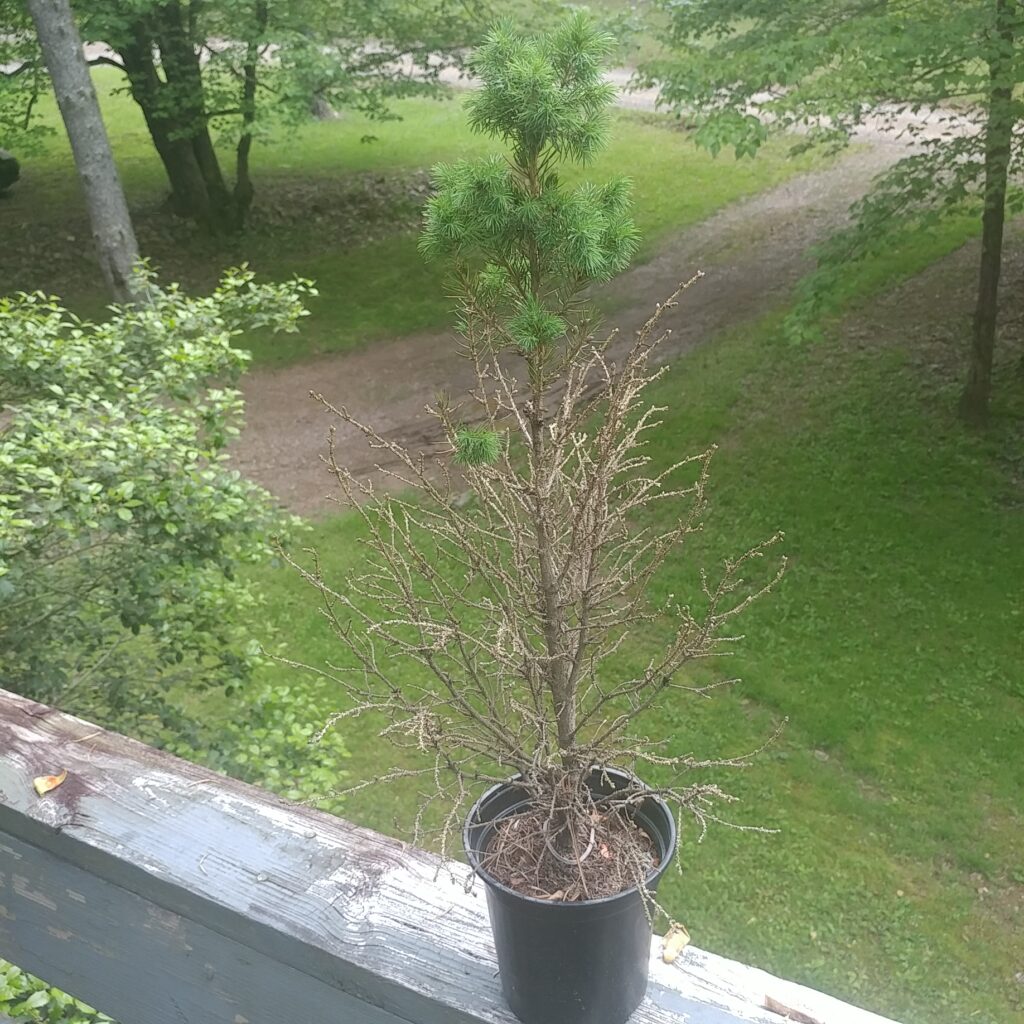
This spruce was a memorial gift, so I’m trying to save it. When we received it (2yrs ago) it almost immediately started dropping needles. The potting mixture was moist so I refrained from watering until the top inch or so was dry. I didn’t find any mites, mold or rot anywhere on it. I kept it indoors over the winter to be safe (we’re in North Carolina so the winter’s aren’t bad here). Over the past 2yrs, no new needles have dropped and the top (green) part has shown new growth.
The “bald” branches are not dry and still flexible. Will new branches grow in if I prune the bald branches back to the trunk or will I end up with a green Q-tip for many years? Is there any way to save it?
I am sorry to see that your memorial spruce is struggling. It looks like you have a Dwarf Alberta Spruce, or Picea glauca ‘Conica’. This lovely small evergreen was first spotted in 1904 in the Rocky Mountains around Lake Laggan, now known as Lake Louise, in Alberta, Canada. This gives us clues to its ideal growing conditions of very cold winters and cool summers, moist fertile soils, great air circulation, low humidity and gentle full sunlight with maximum temperatures in the low 20’s celsius.
North Carolina is in USDA plant hardiness zone 6-8. If you live in the west of the state, in or around the Blue Ridge Mountains, you are nearing the upper limit of the ideal outside growing conditions – which are zones 2-7. If you live in the central or coastal areas (in zones 7-8), your Dwarf Alberta Spruce is likely to struggle due to the warmer, humid growing conditions.
Dwarf Alberta Spruce can be kept indoors for short periods. They are a popular mini Christmas tree, but require a lot of care and will not typically thrive in an indoor pot for extended periods. You maybe able to keep the tree alive, but it will grow very slowly with sparse or patchy growth.
Although it is difficult to see the scale of your tree and its pot, it looks like a tight fit. Typically, your spruce would prefer a pot about 6 inches wider in diameter than the rootball. You could repot your tree into a bigger pot, but ideally it would prefer to be planted outside in the ground.
Dwarf Alberta Spruce develop strong, long lateral roots, to keep them upright on windy mountains in their native range. If they are potted, these roots will quickly become encircled in your pot- requiring repotting or root pruning every 1-2 years while the tree is dormant.
If you live in an apartment, I would consider planting your spruce in a larger insulated pot or urn and placing it on your balcony. It is likely to take years to recover and will look like a green Q tip for some time, but you can add ground covers, bulbs, small grasses and any perennials suited to your conditions to hide the bald areas, while you wait for it to regenerate.
If planted outside, wrap your tree in winter for protection and make sure that it is adequately hydrated going into winter. This will help prevent desiccation and browning off.
The bald branches may still be alive if they are flexible, which means they have the potential to sprout new growth eventually- so don’t prune them back just yet. Branches will not regrow from the trunk once removed.
Unfortunately, these little spruce take a long time to fill in and may still end up with areas that don’t leaf out in spring. I have one that was in a similar state to yours that has completely filled in and the areas that didn’t recover fully have been filled in by new growth from nearby branches. It took about 12 years!
If you have a garden, find a sunny spot away from full afternoon sun for planting. This tree could grow to 8 feet tall in your area and about 5 feet wide, so pick a spot where it will have room to grow in years to come.
In case you need some planting advice, I have added a link below to our garden guide on planting. Alberta Spruce don’t like clay soils as they cannot drain freely.
Water thoroughly after planting and mulch around your spruce with a thick layer of shredded bark mulch, or similar product. Keep the mulch at least 2 inches away from the trunk to prevent fungal infection which can cause the trunk to rot.
For the first year, water the tree at least weekly, saturating the soil to a depth of at least 3 inches. You may need to water more often over your warmer summer months.
Your tree will be working hard to recover from this injury, so aim to fertilize annually with fish emulsion or a granular slow release fertilizer, to provide extra nutrients.
Bringing this small tree back to optimal health is a slow process, but hopefully it will be worth it!

